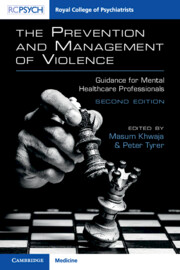Book contents
- The Prevention and Management of Violence
- The Prevention and Management of Violence
- Copyright page
- Dedication
- Contents
- Contributors
- Preface
- Abbreviations
- Section 1 General Aspects of Management
- Section 2 Medical and Psychological Intervention
- Section 3 Violence in Different Settings
- Introduction to Section 3
- Chapter 9 Management of the Risk of Violence in the Community
- Chapter 10 Management of Violence in Acute Medical Hospital Settings
- Chapter 11 Forensic Psychiatry and Adult Inpatient Secure Settings
- Chapter 12 Management of Violence in Prisons
- Section 4 Management in Other Groups
- Section 5 Violence and Society
- Section 6 Engagement and Understanding
- Index
- References
Chapter 11 - Forensic Psychiatry and Adult Inpatient Secure Settings
from Section 3 - Violence in Different Settings
Published online by Cambridge University Press: 09 May 2023
- The Prevention and Management of Violence
- The Prevention and Management of Violence
- Copyright page
- Dedication
- Contents
- Contributors
- Preface
- Abbreviations
- Section 1 General Aspects of Management
- Section 2 Medical and Psychological Intervention
- Section 3 Violence in Different Settings
- Introduction to Section 3
- Chapter 9 Management of the Risk of Violence in the Community
- Chapter 10 Management of Violence in Acute Medical Hospital Settings
- Chapter 11 Forensic Psychiatry and Adult Inpatient Secure Settings
- Chapter 12 Management of Violence in Prisons
- Section 4 Management in Other Groups
- Section 5 Violence and Society
- Section 6 Engagement and Understanding
- Index
- References
Summary
Forensic psychiatry is a medical discipline, developed from the foundations of the asylum era, which focuses on the assessment and treatment of offenders with mental disorders. The complexity of the patient cohort is arguable reflected in the complexity of their clinical pathways, which necessitates some understanding of the legal system that for most patients, works in parallel to that of health and social care. In this chapter, we briefly review the historical context through which modern forensic psychiatry has emerged within England and Wales. This includes some high-profile individual cases that led to the development of concepts such as fitness to plead and the psychiatric defence of not guilty by reason of insanity. We then provide an outline of how inpatient secure services are structured, the relevant criminal sections of the Mental Health Act at each stage of the trial process and some of the challenges associated with managing this complex cohort of individuals.
- Type
- Chapter
- Information
- The Prevention and Management of ViolenceGuidance for Mental Healthcare Professionals, pp. 166 - 186Publisher: Cambridge University PressPrint publication year: 2023



